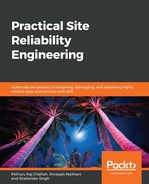The Docker idea has shaken the software world. A bevy of hitherto-unknown advancements are being realized through containerization. The software portability requirement, which has been lingering for a long time, gets solved through the open source Docker platform. The real-time elasticity of Docker containers hosting a variety of microservices enabling the real-time scalability of business-critical software applications is being touted as the key factor and facet for the surging popularity of containerization. The intersection of microservices and Docker containers domains has brought in paradigm shifts for software developers, as well as for system administrators. The lightweight nature of Docker containers along with the standardized packaging format in association with the Docker platform goes a long way in stabilizing and speeding up software deployment.
The container is a way to package software along with configuration files, dependencies, and binaries required to enable the software on any operating environment. There are a number of crucial advantages; they are as follows:
- Environment consistency: Applications/processes/microservices running on containers behave consistently in different environments (development, testing, staging, replica, and production). This eliminates any kind of environmental inconsistencies and makes testing and debugging less cumbersome and less time-consuming.
- Faster deployment: A container is lightweight and starts and stops in a few seconds, as it is not required to boot any OS image. This eventually helps to achieve faster creation, deployment, and high availability.
- Isolation: Containers running on the same machine using the same resources are isolated from one another. When we start a container with the docker run command, the Docker platform does a few interesting things behind the scenes. That is, Docker creates a set of namespaces and control groups for the container. The namespaces and control groups (cgroups) are the kernel-level capabilities. The role of the namespaces feature is to provide the required isolation for the recently created container from other containers running in the host. Also, containers are clearly segregated from the Docker host. This separation does a lot of good for containers in the form of safety and security. Also, this unique separation ensures that any malware, virus, or any phishing attack on one container does not propagate to other running containers. In short, processes running within a container cannot see and affect processes running in another container or in the host system. Also, as we are moving toward a multi-container applications era, each container has to have its own network stack for container networking and communication. With this network separation, containers don't get any sort of privileged access to the sockets or interfaces of other containers in the same Docker host or across it. The network interface is the only way for containers to interact with one another as well as with the host. Furthermore, when we specify public ports for containers, the IP traffic is allowed between containers. They can ping one another, send and receive UDP packets, and establish TCP connections.
- Portability: Containers can run everywhere. They can run in our laptop, enterprise servers, and cloud servers. That is, the long-standing goal of write once and run everywhere is getting fulfilled through the containerization movement.
There are other important advantages of containerization. There are products and platforms that facilitate the cool convergence of containerization and virtualization to cater for emerging IT needs.
